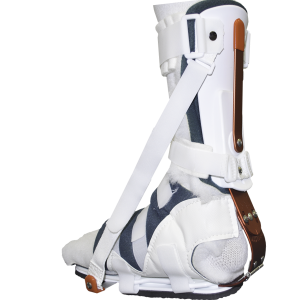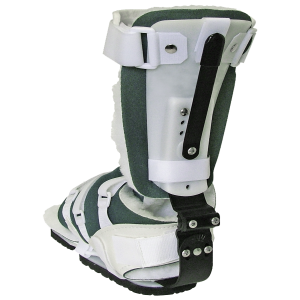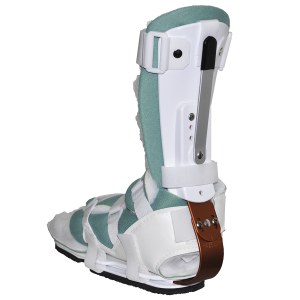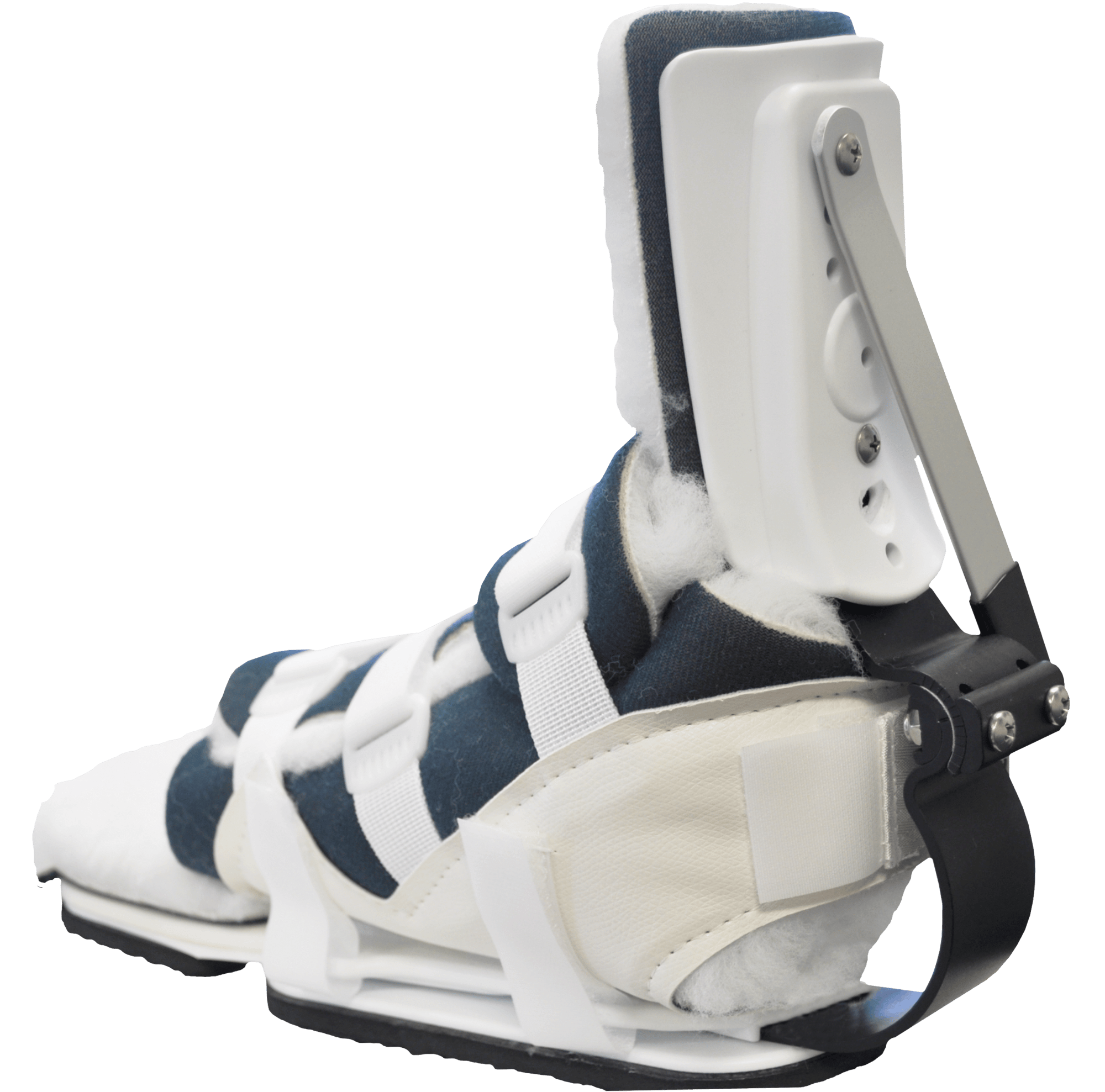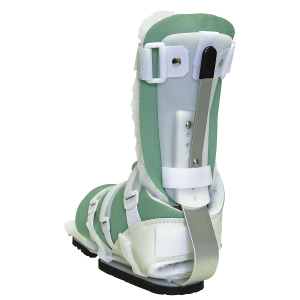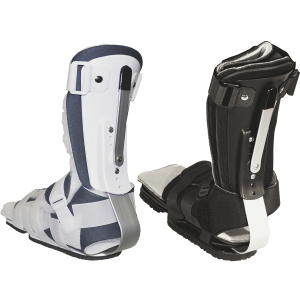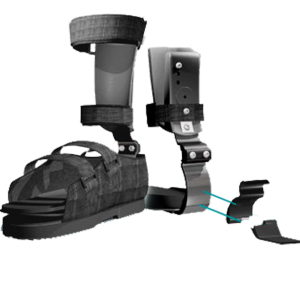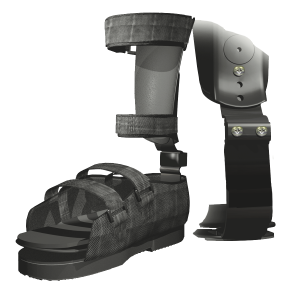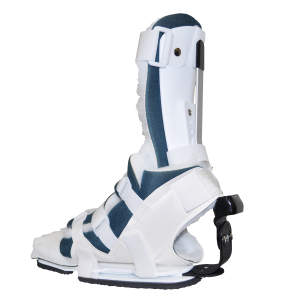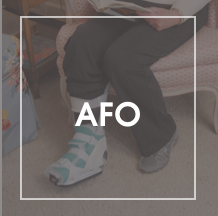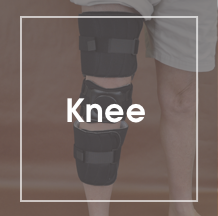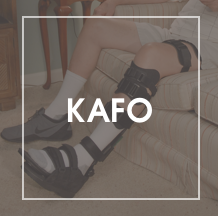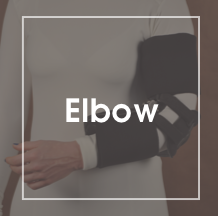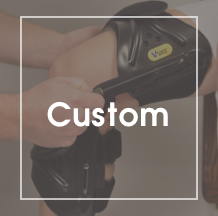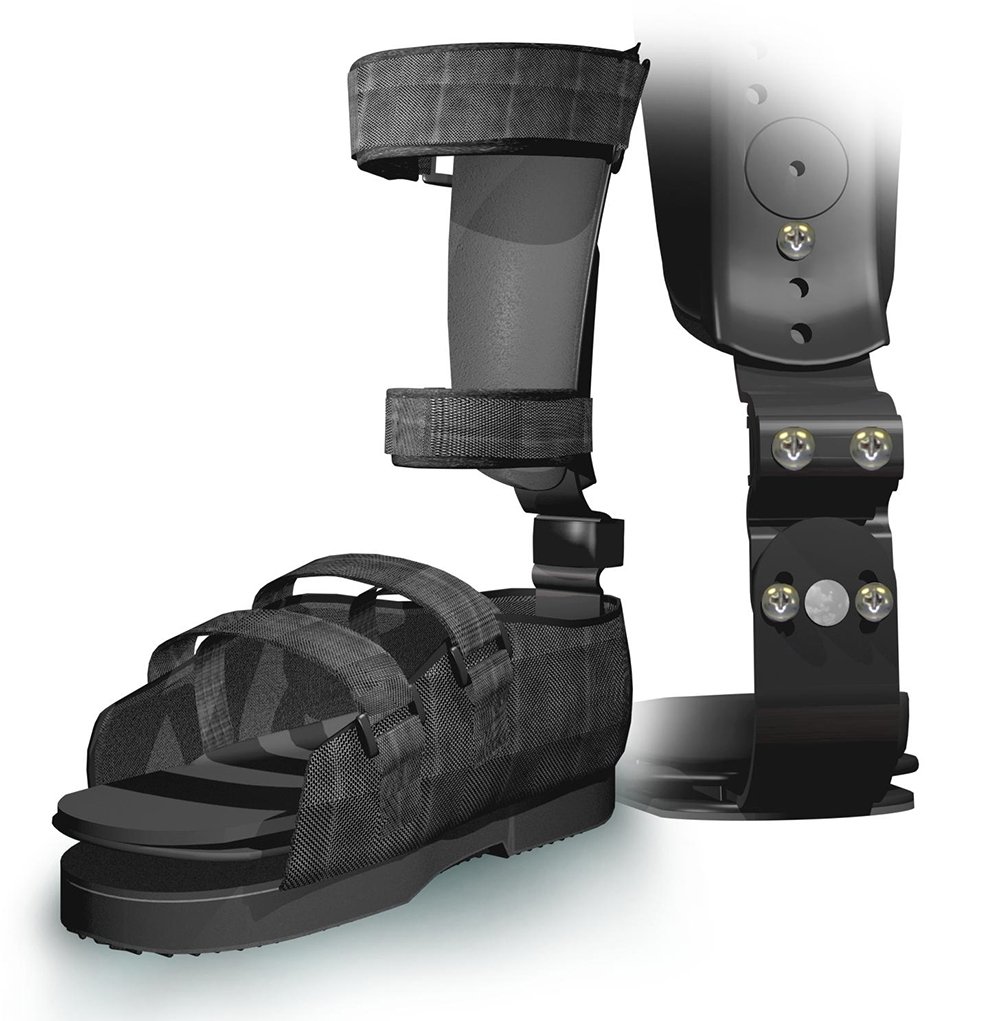
ABBY™ Articulating Ankle Foot Orthosis (AFO)
ABBY™ Articulating Ankle Foot Orthosis is a multi-functional posterior dual-jointed AFO for your patients in the earliest stages of rehabilitation. With a stable base of support for ambulation, it replicates the bio-mechanical effects of a semi solid or PLS AFO.
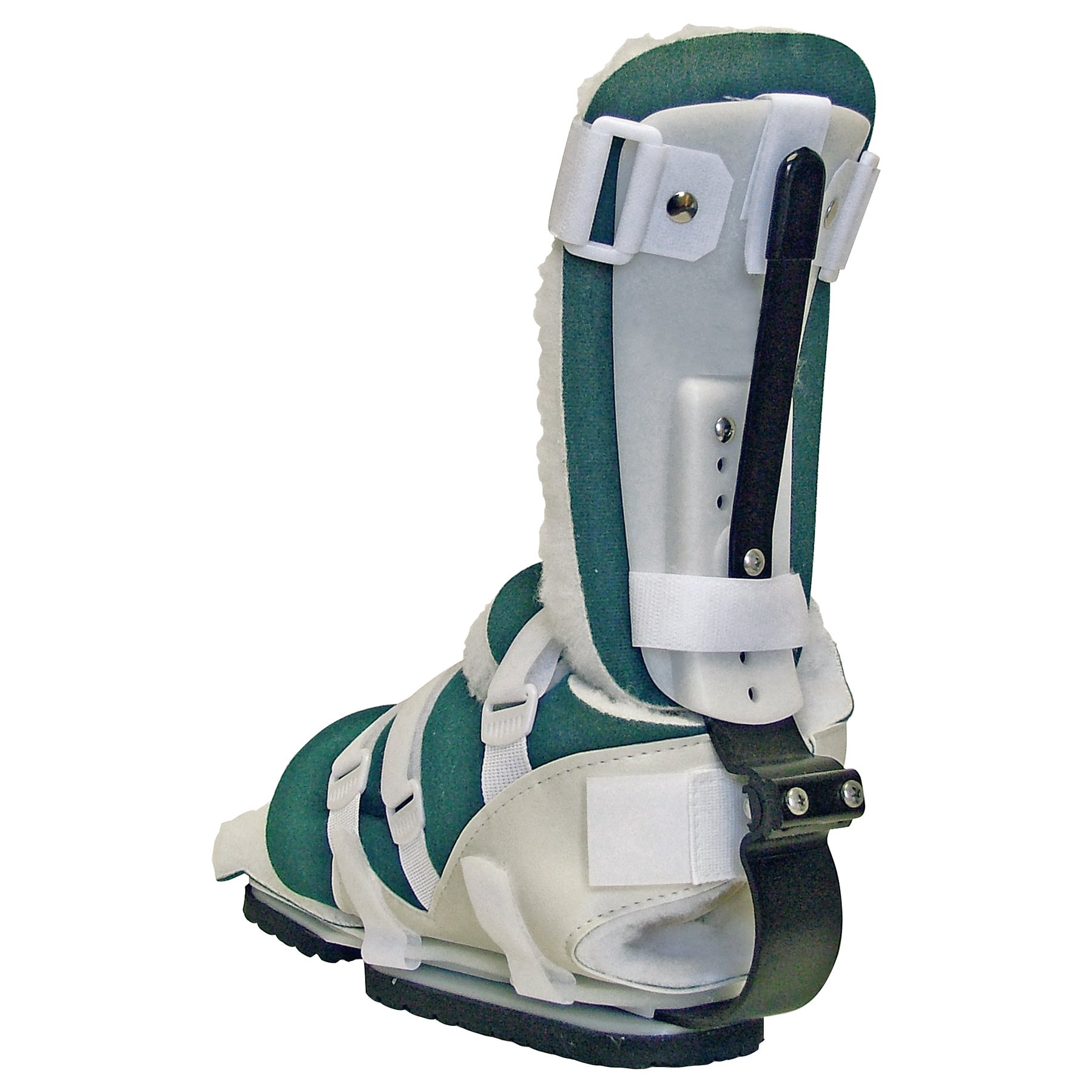
APU® Articulating Ankle Foot Orthosis (AFO)
The APU® Articulating Ankle Foot Orthosis is an Adjustable Posterior Upright design that provides the practitioner a more precise, simplified, and calibrated method of setting the optimal + or – 30º dorsi/plantar flexion angle for the patients foot ankle complex.

Bariatric Ankle Foot Orthosis (AFO)
Anatomical Concepts Inc. introduces the Bariatric Orthosis. This AFO was designed to accommodate your larger patients. The Bariatric Orthosis can be used on the ambulatory and recumbent patient. Comes with a standard 3/16" aluminum heavy-duty heel bar.
We also offer an APU® (Adjustable Posterior Upright) option, utilizing our heavy-duty APU® joint.
AFO Frequently Asked Questions
What is an ankle foot orthosis and when would my doctor prescribe it for me?
An ankle foot orthosis (AFO) is a medical device designed to provide support and alignment to the ankle and foot. It is prescribed by a doctor when a patient requires assistance in managing specific conditions or mobility issues related to their lower limbs.
A doctor may prescribe an AFO under various circumstances, including:
Foot Drop: AFOs are commonly prescribed for patients with foot drop, a condition where they have difficulty lifting the front part of their foot. This can result from neurological conditions like stroke or nerve damage.
Gait Abnormalities: Patients with gait abnormalities caused by conditions such as cerebral palsy, multiple sclerosis, or muscular dystrophy may benefit from AFOs to improve their walking pattern and stability.
Arthritis: AFOs can help individuals with arthritis by providing stability and reducing joint pain.
Orthopedic Conditions: Patients with muscle weakness, deformities, or structural issues in the lower limbs can be prescribed AFOs to correct alignment and support their mobility.
Your doctor will prescribe an AFO after a thorough evaluation of your condition, medical history, and mobility goals. The AFO is custom-tailored to your specific needs to enhance your mobility, alleviate discomfort, and improve your overall quality of life.
What types of conditions or patient cases can benefit from AFOs?
Ankle Foot Orthoses, or AFOs, can benefit a wide range of conditions and patient cases.
They are commonly prescribed for individuals with:
Cerebral Palsy: Patients with cerebral palsy often benefit from AFOs. These devices help improve gait, stability, and overall mobility in individuals with muscle tone and motor control impairments.
Stroke Survivors: Stroke survivors often experience difficulties with foot clearance and control. AFOs can provide the necessary support and alignment to enhance walking ability.
Muscular Dystrophy: AFOs are used in cases of muscular dystrophy to aid patients in maintaining stability and mobility. These conditions are characterized by progressive muscle weakness.
Charcot-Marie-Tooth Disease: This hereditary condition leads to muscle weakness and a decrease in motor skills. AFOs can be helpful in managing the effects of this condition on foot and ankle function.
Multiple Sclerosis: Patients with multiple sclerosis may experience foot drop, muscle weakness, and difficulty with balance. AFOs can help address these symptoms and improve walking ability.
Spinal Cord Injuries: Individuals with spinal cord injuries may use AFOs to enhance mobility and reduce the risk of tripping or falling.
Pediatric Orthopedic Issues: Children with congenital conditions, developmental delays, or orthopedic disorders can also benefit from AFOs to aid in proper growth and development.
It's essential to consult with a healthcare professional or orthotist to determine the most suitable AFO for a specific condition and to ensure proper fitting and customization based on the patient's needs.
How do I choose the most appropriate AFO for my patient?
Choosing the most appropriate Ankle Foot Orthosis (AFO) for a patient involves a comprehensive evaluation and considerations that take into account the patient's condition, lifestyle, and specific needs.
Here's a step-by-step guide to help in the decision-making process:
Assessment by a Healthcare Professional: Start by having the patient assessed by a physician, physical therapist, or orthotist who specializes in orthotic devices. This assessment will determine the patient's specific condition and needs.
Diagnosis and Gait Analysis: An accurate diagnosis of the patient's condition is crucial. Additionally, a gait analysis can help understand the patient's walking patterns and any abnormalities that need correction.
Consider the Patient's Goals: Discuss the patient's goals and expectations. Some patients aim to walk more comfortably, while others may want to engage in more physical activities. Understanding these goals will help in device selection.
Type of AFO: AFOs come in various types, such as rigid, articulated, or dynamic. The choice depends on the patient's condition. For instance, a rigid AFO provides excellent support for drop foot, while dynamic AFOs offer more flexibility and support for gait abnormalities.
Customization: Custom-fit AFOs are often the best choice. They can be molded and designed to fit the patient's unique anatomical structure and provide optimal support and comfort.
Material and Design: The material used in the AFO (e.g., plastic, carbon fiber, metal) and the design (e.g., full-length, posterior leaf spring, solid shell) should align with the patient's condition and functional requirements.
Comfort and Compliance: Ensure that the AFO is comfortable to wear for extended periods. Patient compliance is crucial for the effectiveness of the orthosis.
Shoe Compatibility: Consider the type of shoes the patient prefers to wear. The AFO should fit comfortably inside the patient's chosen footwear.
Insurance Coverage: Check insurance coverage for orthotic devices. Some AFOs may be covered, but specific requirements may need to be met.
Follow-Up Care: Regular follow-up appointments are essential to monitor the patient's progress, make any necessary adjustments, and ensure the AFO continues to meet their needs.
Patient Education: Educate the patient about proper use, care, and maintenance of the AFO to ensure its longevity and effectiveness.
Collaboration: Work closely with an orthotist or orthopedic specialist to select, fit, and adjust the AFO appropriately.
Remember that each patient is unique, and the selection of the most suitable AFO should be based on their individual medical condition, lifestyle, and preferences. Regular assessments and adjustments may be needed to optimize the AFO's effectiveness over time.
Can AFOs be customized for specific patient needs and anatomical variations?
Yes, Ankle Foot Orthoses (AFOs) can indeed be customized to address specific patient needs and anatomical variations. The customization process ensures that AFOs are tailored to the individual's unique condition and requirements.
Here's how AFOs can be customized:
Patient Assessment: The process begins with a thorough assessment of the patient's medical condition and gait abnormalities. This assessment helps in understanding the specific needs of the patient.
3D Scanning or Casting: AFOs can be custom-fitted using 3D scanning technology or traditional casting methods. This captures the patient's anatomical structure accurately.
Custom Mold and Design: Based on the assessment and scan or cast, a custom mold and design are created for the AFO. This ensures that the orthosis fits the patient's foot and leg precisely.
Material Selection: Various materials, such as plastic, carbon fiber, metal, or a combination, can be chosen based on the patient's needs. For instance, lightweight materials are suitable for more active patients.
Specific Condition Consideration: The design and features of the AFO are tailored to address the patient's specific medical condition. For example, if a patient has drop foot, the AFO may have a dorsiflexion assist to help with foot clearance during walking.
Ankle and Foot Alignment: Customization ensures that the AFO aligns the ankle and foot correctly, addressing any issues with stability and gait.
Pressure Relief and Comfort: Accommodations are made to enhance the comfort of the AFO, reducing the risk of pressure sores and discomfort.
Strap and Closure Adjustments: Straps, closures, and fasteners can be adjusted to ensure a secure fit and ease of use.
Shoe Compatibility: The AFO can be designed to fit comfortably inside the patient's preferred shoes, taking into account the patient's daily activities and footwear choices.
Follow-Up and Adjustments: Regular follow-up appointments are scheduled to evaluate the AFO's performance and make any necessary adjustments as the patient's condition evolves.
Customization allows AFOs to provide the best possible fit, support, and comfort for patients. It ensures that the orthosis addresses the patient's unique anatomical variations and medical needs, ultimately leading to better outcomes and increased quality of life.
AFO-Related Articles
AFO Buying Guide: What to Consider When Choosing an Ankle-Foot Orthosis
Ankle Foot Orthosis AFO : Effective Treatment For Plantar Fasciitis
An Orthosis Can Help Manage Pain & Instability Caused by Multiple Sclerosis (MS)
Respond to Plantar Flexion Weakness with an Ankle-Foot Orthosis (AFO)
 330-757-3569
330-757-3569







